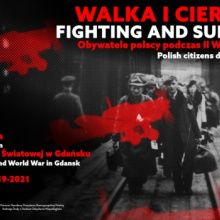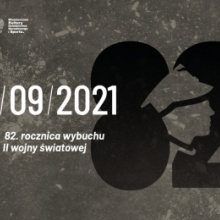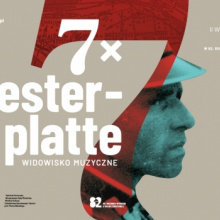- 'At Westerplatte we should talk about the unique, symbolic dimension of this place because it was there that the first battle of World War II began, and Polish soldiers demonstrated the highest virtues in service to the civic community,' says dr hab. Grzegorz Berendt prof. UG from the Faculty of History UG and acting director of the World War II Museum in Gdańsk. Ewa Karolina Cichocka asks about his reflections on the 82nd anniversary of the outbreak of World War II, his research and museum plans.
- September 1, 1939, is one of the most important dates for Poland. The beginning of World War II is an important caesura in Polish history. Do we still remember these events today and do they influence our lives?
- In European history, for the majority of societies that fell victim to aggression from the German Reich, or more precisely the so-called Third Reich, September 1, 1939, marks the beginning of a world war that has had no parallel in the history of mankind so far. Its unprecedented character was determined by the number of deaths and by the plans and practice of annihilating millions of defenceless civilians. Of course, at that time new types of weapons with high or even great power of destruction were used (e.g. missiles, nuclear weapons).
Nevertheless - in my opinion - the dark uniqueness of this conflict is primarily related to the cumulation of genocidal actions. I know of no other analogous event in which the killing of a dozen million people and the expulsion of tens of millions more was coldly accepted. The first intention involved the Jews and we know it by at least several names: Holocaust and Shoah. The second was the expulsion of tens of millions of Slavs from Europe, mostly Poles, Belarussians, Ukrainians and Russians. It went down in history as the General Eastern Plan.
The fate of the Jews indicates what this planned 'liberation' of space from the Slavs might have consisted of. Let us not forget that the concentration camps were constantly being expanded and it was planned to hold tens of thousands of people in some of them at a time. If by 1944, most of the Jews and Sinti/Roma in the areas controlled by Hitler's Reich had already been murdered, the question arises as to who was to fill the new barracks in the main camps and sub-camps, such as Auschwitz or Stutthof?
- I have more than once come across the statement that there is no point in dwelling on the past. That we should concentrate on the here and now and on the future. And this is often said by people who at the same time advocate broadening one's horizons and being open to knowledge. Meanwhile, how can one understand today's relations between neighbouring states and nations without knowledge of the events of the past, above all the most recent, which have determined it?
There is not a family in our country that did not suffer losses during the Second World War. Relatives died, and the material possessions worked out by generations of ancestors were destroyed or diminished. Knowledge of the family experience of war is in the hands of every person interested in something more than "physical existence".
It is obvious that the activity of the dominant part of people is concentrated on current affairs and the pursuit of the adopted goals. However, this is not in contradiction with the knowledge of history, both the family history and the wider history. They help us better understand the surrounding world. Life observations indicate that the most ardent advocates of not dwelling on past events are those who have a personal or family problem with past actions. Wrong choices and negative behaviour they would most like to cover with a curtain of silence and forgetfulness. However, their personal problems should not generate social amnesia.
Does the Second World War past affect our lives? This is a rhetorical question. How can we understand the disputes and arguments between Poles and Belarusians, Germans, Russians, Ukrainians or Jews without knowledge of the events of 1939-1945, but also earlier and later? After all, they are our neighbours, we should know what they think of us and why.
- The number of guests who have visited the Museum of the Second World War reaches 2 million people. Looking at this great interest, is it possible today to think that this historical period is still alive and relevant in our memory?
- Between March 2017 and the end of July 2021, around 1.9 million visitors came to the Gdańsk World War II Museum. And it would have been more than 2 million had it not been for the pandemic and the resulting restrictions. During the peak holiday season, i.e. July and August, the museum received more than 60,000 visitors per month in 2018, 2019. Certainly, such a huge interest of visitors is determined not only by the visual attractiveness of the exhibitions presented but also by their subject matter. I suppose that if collections of buttons were placed in the same place and the same space, visitors would not stand in line for two hours at a time to see them for years to come. This is not to belittle the role of buttons in the history of fashion development. However, the attempt to find out what the cataclysm of the Second World War meant for humanity is, in my opinion, the strongest magnet which has drawn crowds of visitors to this museum. Of course, the intensive promotional campaign also has an impact on the interest. But let us emphasise that their effectiveness is due to the fact that they have an attractive 'product'to advertise.
- The work and the most important archaeological discoveries at Westerplatte and the plans to build a new museum devoted to the war of 1939 show that it is not just a place on the historical map of Poland. What is happening there now? What work is being carried out and what are the further plans?
- The creation of the Museum of Westerplatte and the 1939 War at the end of 2015, and its subsequent inclusion as a branch of the Second World War Museum, initiated the first systematic archaeological research on such a large scale in the history of the peninsula. As a result, tens of thousands of objects from various periods have been collected. Museum staff are now working on their description and conservation.
The analysis of historical sources made it possible to select the place where the bodies of the fallen defenders of the Polish Military Transit Depot (WST) were buried on German orders. Excavations conducted in 2019 have revealed the remains of several people. So far, the identity of six of them as soldiers from the WST crew has been confirmed. In addition, the remains of German soldiers killed during the battle for Westerplatte in March 1945 have been revealed. As a result of an exhumation carried out in 2021 at the military cemetery, it was established that the remains buried in the military cemetery in the 1990s were not the earthly remains of a Polish soldier, Corporal Kowalczyk, but the skeleton of a German soldier, buried with some of his military gear.
These coverings show that Westerplatte still hides real and not imaginary secrets. The systematic work of archaeologists and the historians who support them provides new findings and today our knowledge of the site is greater than in the summer of 2015. And yet so far archaeologists have only examined a few % of the former WST site.
During the sapper, checks preceding each archaeological exploration, about a ton of unexploded bombs and unexploded ordnance were revealed for five years, including a half-ton bomb lying 30 cm below the surface of the ground not far from one of the trails hiked by tourists. So, indirectly, the search has contributed to reducing the risk of uncontrolled explosions that are dangerous to people and animals.
Numerous and complicated works are leading to the fact that in the second half of next year a new military cemetery will be ready, where the remains of Major Henryk Sucharski and his subordinates found on the battlefield will rest. It will expose more than 200 objects excavated by archaeologists since 2016. But not only...
In parallel, work is being carried out to reconstruct the building where the stationmaster, who controlled the movement of railway trains on the peninsula, used to work. Such reconstructions will concern former warehouses Nos. 1, 8, 10, 11 and 12. They must be carried out in such a way as to protect the relics remaining in the original buildings. They will tell the story of Westerplatte up to August 31, 1939, the battle, the surrender and the slave labour of thousands of Poles and Jews over the next two years. The Fort site will be made available for exhibition purposes.
The activities carried out are in constant consultation with the office of the Provincial Conservator of Monuments. Additional conservation work is planned in the ruins of the so-called new barracks. The project also involves the construction of a new exhibition space on the plot of land at the foot of the mound on which the monument to the Defenders of the Coast stands. This building, sunk in the ground, will house a permanent exhibition on the Polish campaign of 1939, including the fighting of the last Polish Army units in the autumn of 1939 and the spring of 1940.
In a separate room, visitors will be able to learn about the biographies of the defenders and copies of historical sources containing information about the WST. There will be two places under the open sky for visitors to relax and learn about the fauna and flora of the peninsula. In addition, outside the area of the former warehouse, thanks to an agreement with the Port of Gdańsk, a car park for about 180 cars and a modern tourist service point will be set up. Funding for these tasks will be provided by the Polish Government.
The completion of the investment will ultimately provide another space in Gdańsk where visitors from Poland and abroad will be able to spend at least several hours. This will make them plan a longer stay in our city, which is undoubtedly very important for us as inhabitants in times of seeking new sources of individual and collective income. Actions aimed at slowing down or even torpedoing this investment actually strike at the common interest of the residents of Gdańsk, Pomerania and Poland. At Westerplatte we can and should speak of the unique, symbolic dimension of this place because it was there that the first battle of the Second World War began, and Polish soldiers demonstrated the highest qualities in their service to the civic community. They did their duty. We must ensure that their memory is not lost.
- Thank you for the interview.
September 1, 2021, at the Museum of the Second World War
From September 1 until the end of the year, the Museum of the Second World War will open a temporary exhibition entitled Fighting and Suffering. Polish citizens during World War II, concerning Polish experiences of World War II, with a special emphasis on the horror and tragedy of those times.
On September 1, 2021, as part of the celebrations of the 82nd anniversary of the outbreak of World War II, the Museum of World War II will hold an opening, screenings, lectures and a musical performance:
9.00 - vernissage of the temporary exhibition entitled When the days were fulfilled... The burials of the Polish defenders of Westerplatte,
15.00 - screening of the film Free City (dir. Stanisław Różewicz, 1958) after digital reconstruction by the WWII Museum,
15.30 - a lecture by dr hab. Grzegorz Berendt, director of the WWII Museum, entitled 'The aggression of the Third Reich against Poland in front of the Nuremberg Tribunal',
16.30 - presentation by dr hab. Grzegorz Berendt, Director of the WWII Museum and dr Karol Nawrocki, President of the Institute of National Remembrance (IPN), entitled The Museum of Westerplatte and the War of 1939,
20.15 - musical performance entitled 7 x Westerplatte on the square in front of the Museum of the Second World War. Live broadcast on TVP1.
The Museum will be open to visitors on that day from 6.00 a.m. to 6.00 p.m. (Admission to the main exhibition and temporary exhibitions throughout the day - 1 zł).
https://muzeum1939.pl/kalendarz



